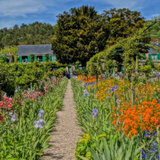Thank you Fiona Ludbrook for sharing this beautiful blog with us. For more information and blogs visit Fiona's website here.
Anyone lucky enough to visit impressionist artist Claude Monet’s garden, Le Clos Normand in Giverny, cannot fail to be impressed by the way Monet’s garden is alive with a profusion of plantings and colour. Light and colour truly appear to dance in Monet’s garden but it is really just a masterful illusion.
You too can learn to manipulate the appearance of your garden to use light colours and light to best effect, by embracing even a few of Monet’s tricks!
Though most gardens tend to appear washed out in the harsh midday sun compared to the early morning and evening, when softer light, actually enhances colour, these photos were all taken between 12.45 and 4.00 pm in late spring. Monet used bright reds, hot pinks and oranges in the centre of his garden, where midday sun will fall and so still have the garden looking bright, despite the maximum light intensity and colour washout potential!
I took these photos under what most photographers believe to be the worst possible conditions; a bright sunny day. My shots should, in theory, look flat and washed out. That they do not is a testament to Monet’s knowledge of colour and how to manipulate it to make a garden truly glow, at any time of day!

This photo shows the maximum contrast of the vivid blue and orange, made sparkle by the paler blue irises, and the white verbascums, to make the colours dance in the strong sunlight. Continuing the pale blue irises across the path to frame the salmon pink tulips brings harmony and unifies the scheme, whilst in the evening, the pinks and oranges glow richer, mirroring and enhancing the western light at sunset.

Clematis Montana, frames the house, while combinations of tulips, white bearded iris, tiny pale blue forget me nots and a border of grey-leafed byzantiums (lambs ears), make the colours intensify as they contrast against each other. The white flowers, reflect maximum light, making the garden bed appear to glow with patches of contrasting colour and light!
These colours, planted amongst Monet’s fruit trees, show the dusky pink and green of the house to advantage, or perhaps Monet selected the colour scheme of his home to disappear into the hues of his plantscape?

Dark purple and orange pansies, contrast with pale blue pansies, salmon pink poppies and purple and white tulips. The pale blue forget me nots add another level of colour spectrum depth. Look again and you might notice the purple cornflower and wintersweet wallflower!

The subtle colour variations on this showy tulip, from mid yellow stamen and blue centre to the mauvey pink, white tipped petals all allow for maximum play of colour and the illusion of light moving within the garden.
According to Derek Fells, author of ‘Monet’s Garden’, a book that has become my Bible of planting schemes and use of colour in my own garden, Monet preferred single, rather than double flower forms of plants like hollyhocks, poppies and camellias. Simply because the single flower actually catches the light and increases the gardens luminosity, better than the double flower, whose density holds, rather than bounces colour! The single flower from poppy below also illustrates this!


This is an example of a “sunrise colour scheme”. When lit with early morning sun from the east, such colour schemes will positively glow with and enhance the weak earliest rays of the sun, intensifying colours that are present with lower intensity morning light.

If this bed looks fabulous in the midday sun, just imagine the effect of these sunset colours aglow with maximum intensity as evening light levels fall. These sorts of colour schemes have maximum impact when rays of western light hit them at dusk. We see those colours in the sky at sunset because the light spectrum of that time of day is naturally filled with the purples, pinks, oranges and blues.

More beds designed for light falling from the west at sunset, to make the garden glow with as much intensity as the sky!
 Note the use of vertical plantings and vertical plant manipulation and colour contrasts in this image!
Note the use of vertical plantings and vertical plant manipulation and colour contrasts in this image!
 The horizontal plane is emphasised by pleached apples and pears.
The horizontal plane is emphasised by pleached apples and pears.
Carefully contrived colour, that complements and enhances light and colour throughout the day along with strong horizontal and vertical planes, all create a sense of abundance and nature in its glory. No wonder millions flock to Giverny annually, to be inspired and amazed by Monet’s garden!
 The Water Garden.
The Water Garden.

Contemplations?

Aquilegia (grannie’s bonnet). Every individual flower has its place within a grand planting scheme!
Try taking a leaf out of Monet’s purposeful use of colour design and apply it to your own garden!











